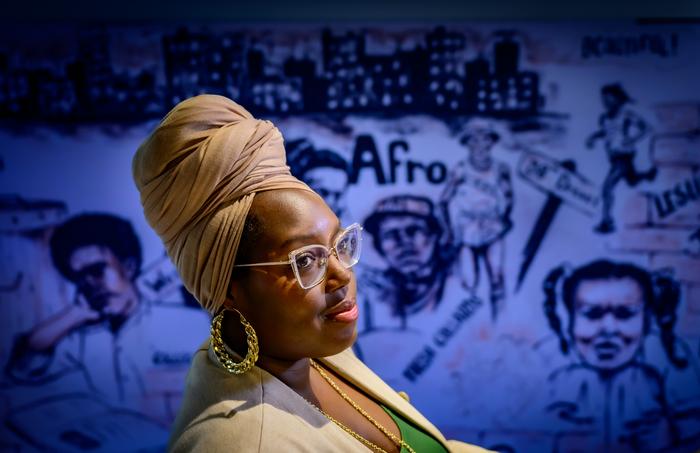In a groundbreaking sociological study led by University of Illinois Urbana-Champaign professor Brittney Miles, the multifaceted nature of Black women’s beauty is unveiled as a profound and deliberate expression of identity, political agency, and cultural resilience. This research dives deep into the intricate connections between aesthetic presentation and socio-political experience, reframing beauty and fashion not merely as superficial concerns but as essential components of activism and self-definition within Black communities.
Miles’ work, conducted through qualitative interviews with 39 Black women across diverse ethnicities, generations, and gender expressions, challenges conventional understandings of beauty standards that historically privileged narrow definitions rooted in whiteness and Eurocentric ideals. The study reveals that Black women, despite their differences in background and personal history, share a collective consciousness about their visibility in a society that frequently seeks to marginalize or erase them. This awareness is reflected in their intentional beauty practices, which act as a visible form of resistance and self-assertion.
At the core of this inquiry is the concept of “embodied resistance,” which refers to the strategic use of the body, attire, and adornment as political tools. This practice is deeply rooted in historical contexts, dating back to resistance against oppressive laws such as the tignon laws of the late 18th century. These laws sought to diminish the social standing of free Black women by forcing them to cover their hair, a key aspect of cultural identity and personal expression. Rather than submitting to these restrictions, many women created visually striking and elaborate headwraps, decorated with jewels and feathers, turning a symbol of domination into one of empowerment and cultural pride.
Miles employed photo elicitation as a methodological innovation in this study, inviting participants to submit images that embodied various dimensions of their identity, including childhood moments, beauty ideals, and political expressions around their Blackness. This visual approach allowed the women to narrate their own stories and assert control over their representation, transforming photography into a dialogic tool that extends beyond words. The images of protest participation and politically charged apparel featured prominently, underscoring how fashion intersects with activism and public discourse.
The research further highlights the significance of cultural symbols such as Kente cloth, which the participants wore to signify panethnic solidarity and political allegiance within the broader African diaspora. Such sartorial choices are not merely ceremonial but are embedded with layered meanings that communicate shared histories, struggles, and aspirations. This symbolic language of fashion contributes to a genealogy of audacious aesthetics where elements like beads, feathers, and voluminous hairstyles are consciously employed to claim space and visibility in social and political arenas.
Importantly, the study places Black women’s beauty practices in conversation with ongoing struggles against systemic policing of Black bodies, ranging from school dress codes to workplace dress expectations. Many participants recounted experiences of having their natural hair, bright clothing, or large jewelry labeled as “unprofessional” or “too loud,” illustrating how dominant norms enforce conformity through subtle but pervasive constraints. Some women resisted these expectations by embracing bold styles that made their presence undeniable, while others conformed out of necessity, navigating complex negotiations between authenticity and survival.
Miles’ analysis also underscores the intellectual influences shaping participants’ perspectives, specifically the work of Black feminist scholars and activists such as Angela Davis and Mikki Kendall. These thinkers offered vital frameworks for reimagining beauty in ways that defy mainstream narratives privileging Eurocentric features and standards. Through these feminist lenses, beauty is recast as a source of strength, rooted in community, heritage, and resistance rather than mere aesthetic appeal.
Moreover, the study situates beauty within temporal dimensions, exploring how adult reflections on girlhood experiences reshape contemporary identities and future trajectories. This intergenerational discourse reveals how imposed beauty norms are internalized, resisted, or transformed over time, influencing how Black women negotiate self-worth amid societal pressures. Miles’ ongoing book project aims to expand on these themes, charting the evolving landscape of Black femininity and beauty politics.
This research carries profound implications for understanding aesthetic expression as inseparable from racial and gendered power dynamics. By documenting the ways Black women use beauty as a form of resistance, the study amplifies voices historically marginalized in both academic and public spheres. The findings call for broader recognition of beauty as a critical site of political contestation and cultural affirmation, challenging reductive stereotypes and advocating for more inclusive definitions of beauty.
Ultimately, Miles’ study reveals that Black women’s fashion and beauty are far more than matters of individual preference or vanity—they are deliberate, visible acts of resilience and empowerment that confront and subvert oppressive social structures. These embodied practices serve as potent political statements that assert identity, demand recognition, and celebrate diversity within Black communities.
The research was supported by the Kunz Center for Social Research and funded through the University of Cincinnati’s Charles Phelps Taft Graduate Enrichment Grant. It adds an important interdisciplinary perspective to sociology, cultural studies, and fashion scholarship, offering new methodological approaches and critical insights into the politics of appearance in contemporary society.
In highlighting this complex interplay between beauty, identity, and activism, the study not only enriches academic discourses but also resonates widely with ongoing social movements aimed at dismantling systemic racism and promoting cultural equity. By centering Black women’s voices and experiences, Miles provides a framework for understanding the transformative power of aesthetics as a form of resistance and social engagement.
Subject of Research: People
Article Title: Capturing Black beauty: Ontological beauty through photo-elicitation
Web References: http://dx.doi.org/10.1386/csfb_00091_1
References: Miles, B. (Year). Capturing Black beauty: Ontological beauty through photo-elicitation. Critical Studies in Fashion and Beauty. DOI: 10.1386/csfb_00091_1
Image Credits: Photo by Fred Zwicky
Keywords: Sociology, Cultural diversity, Social discrimination, Activism




